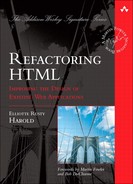Book Description
Like any other software system, Web sites gradually accumulate “cruft” over time. They slow down. Links break. Security and compatibility problems mysteriously appear. New features don’t integrate seamlessly. Things just don’t work as well. In an ideal world, you’d rebuild from scratch. But you can’t: there’s no time or money for that. Fortunately, there’s a solution: You can refactor your Web code using easy, proven techniques, tools, and recipes adapted from the world of software development.
In Refactoring HTML, Elliotte Rusty Harold explains how to use refactoring to improve virtually any Web site or application. Writing for programmers and non-programmers alike, Harold shows how to refactor for better reliability, performance, usability, security, accessibility, compatibility, and even search engine placement. Step by step, he shows how to migrate obsolete code to today’s stable Web standards, including XHTML, CSS, and REST—and eliminate chronic problems like presentation-based markup, stateful applications, and “tag soup.”
The book’s extensive catalog of detailed refactorings and practical “recipes for success” are organized to help you find specific solutions fast, and get maximum benefit for minimum effort. Using this book, you can quickly improve site performance now—and make your site far easier to enhance, maintain, and scale for years to come.
Topics covered include
• Recognizing the “smells” of Web code that should be refactored
• Transforming old HTML into well-formed, valid XHTML, one step at a time
• Modernizing existing layouts with CSS
• Updating old Web applications: replacing POST with GET, replacing old contact forms, and refactoring JavaScript
• Systematically refactoring content and links
• Restructuring sites without changing the URLs your users rely upon
This book will be an indispensable resource for Web designers, developers, project managers, and anyone who maintains or updates existing sites. It will be especially helpful to Web professionals who learned HTML years ago, and want to refresh their knowledge with today’s standards-compliant best practices.
This book will be an indispensable resource for Web designers, developers, project managers, and anyone who maintains or updates existing sites. It will be especially helpful to Web professionals who learned HTML years ago, and want to refresh their knowledge with today’s standards-compliant best practices.
Table of Contents
- Copyright
- Praise for Refactoring HTML
- The Addison-Wesley Signature Series
- Foreword by Martin Fowler
- Foreword by Bob DuCharme
- About the Author
- 1. Refactoring
- Why Refactor
- Smell: Illegible Code
- Smell: The CEO Can’t Fill Out His Travel Expense Vouchers
- Smell: Slow Page-Rendering Times
- Smell: Pages Appear Different in Different Browsers
- Smell: Pages Require Dangerous or Nonstandard Technologies
- Smell: Your Company’s Home Page Suddenly Says, “Pwned by Elite Doodz”
- Smell: Your First Appearance on Google Is on Page 17
- Smell: Readers Send E-mail Saying Your Site Is Broken
- When to Refactor
- What to Refactor To
- Objections to Refactoring
- Why Refactor
- 2. Tools
- 3. Well-Formedness
- What Is Well-Formedness?
- Change Name to Lowercase
- Quote Attribute Value
- Fill In Omitted Attribute Value
- Replace Empty Tag with Empty-Element Tag
- Add End-tag
- Remove Overlap
- Convert Text to UTF-8
- Escape Less-Than Sign
- Escape Ampersand
- Escape Quotation Marks in Attribute Values
- Introduce an XHTML DOCTYPE Declaration
- Terminate Each Entity Reference
- Replace Imaginary Entity References
- Introduce a Root Element
- Introduce the XHTML Namespace
- 4. Validity
- Introduce a Transitional DOCTYPE Declaration
- Remove All Nonexistent Tags
- Add an alt Attribute
- Replace embed with object
- Introduce a Strict DOCTYPE Declaration
- Replace center with CSS
- Replace font with CSS
- Replace i with em or CSS
- Replace b with strong or CSS
- Replace the color Attribute with CSS
- Convert img Attributes to CSS
- Replace applet with object
- Replace Presentational Elements with CSS
- Nest Inline Elements inside Block Elements
- 5. Layout
- 6. Accessibility
- Convert Images to Text
- Add Labels to Form Input
- Introduce Standard Field Names
- Turn on Autocomplete
- Add Tab Indexes to Forms
- Introduce Skip Navigation
- Add Internal Headings
- Move Unique Content to the Front of Links and Headlines
- Make the Input Field Bigger
- Introduce Table Descriptions
- Introduce Acronym Elements
- Introduce lang Attributes
- 7. Web Applications
- 8. Content
- A. Regular Expressions
